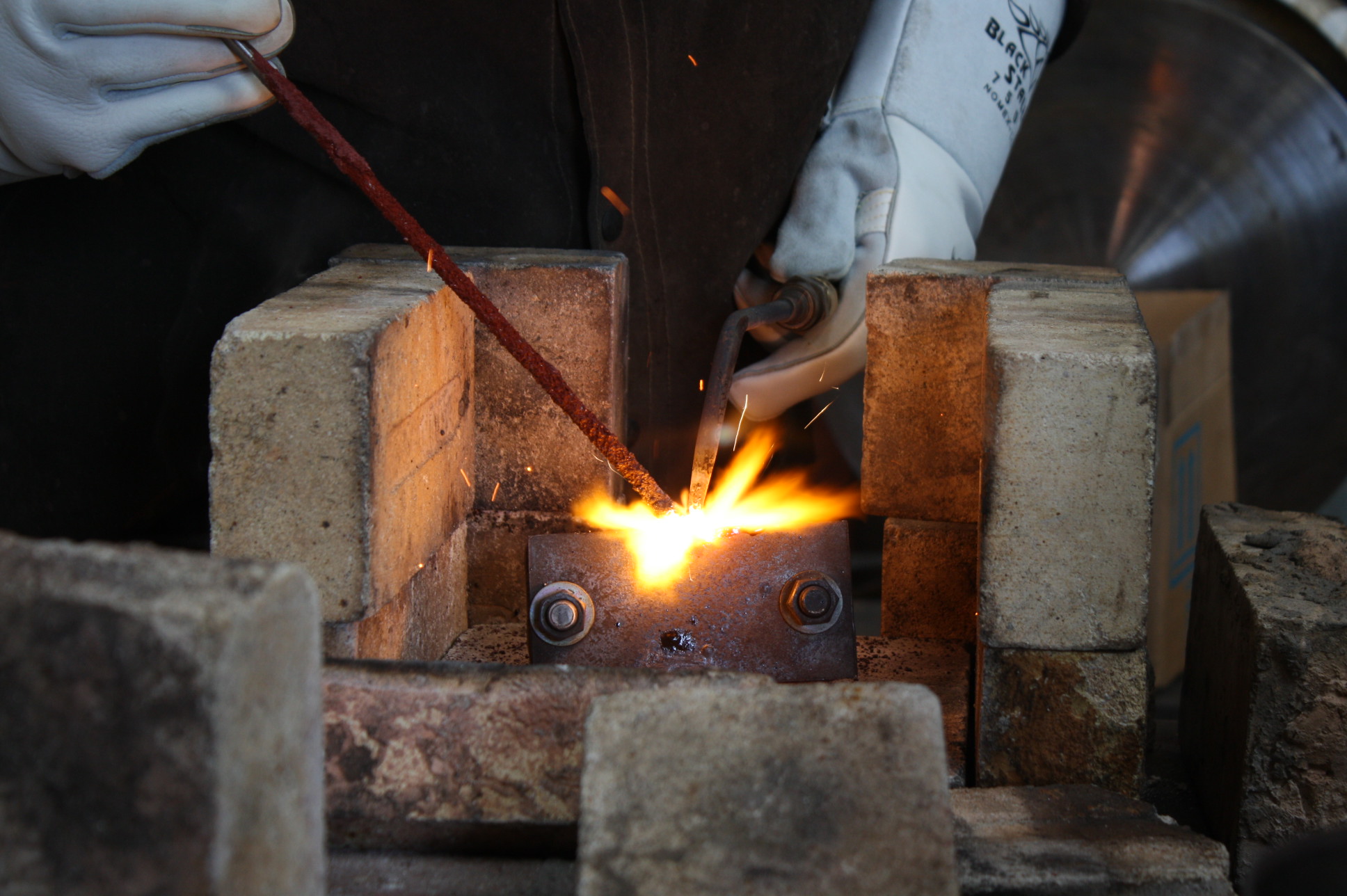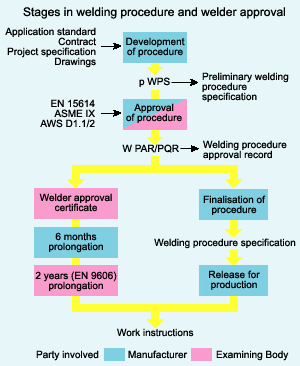Welding Cast Iron
Welding cast iron has proven to be a very difficult task to do. Many professional welders are sweating hard in determining the best way to weld a stubborn cast iron. Many have tried, many have failed, some had succeeded but the realized that their luck will not turn the next time they weld a cast iron.
 Welding cast iron has proven to be a very difficult task to do
Welding cast iron has proven to be a very difficult task to do
Cast iron is one of the alloys of iron that has a significant content of carbon in it. The content of carbon varies from about 2% to 4%. This carbon content is about 10 times greater than it is found in other alloys like wrought iron or steel. The cast iron manufacturing process is simple as a result of its simple combination. The reason why cast iron is very complicated to weld is the carbon content that is much higher in the cast iron than other regular irons. Carbon is actually the ingredient that is used in steels and allows it to be heated to make real hard but definitely useful things like razor blades, drill bits, tools and ball bearings.
Cast iron is difficult, but not impossible, to weld. In most cases, welding on cast iron involves repairs to castings, not joining casting to other members. The repairs may be made in the foundry where the castings are produced, or may be made to repair casting defects that are discovered after the part is machined.
Mis-machined cast iron parts may require repair welding, such as when holes are drilled in the wrong location. Frequently, broken cast iron parts are repaired by welding. Broken cast iron parts are not unusual, given the brittle nature of most cast iron.
Cast irons contains about a full three or four percent carbon, which makes it very hard and vulnerable to weld. Carbon content in cast irons makes the cast iron impossible to dissolve into a metal when it is solidifying from a molten state, and the excess carbon can be found lurking in graphite flakes. These graphite flakes are best for engine blocks and some machine components for they will make lubrication possible in worn surfaces like the cylinder walls. But tough carbon in graphite flakes has its use, which is what makes welding a cast iron very hard.
So generally welding cast iron is difficult, and comes close to impossible, but in particular, welding of cast irons can prove to be a task that can be done if a welder will have the wisdom to differentiate the grades of the cast irons.
There are actually many grades of a cast iron, and the fact is, some cast irons can be easily welded than other form of cast irons. It is quite a handful in telling which is what apart, and it will take an experienced welder who has been in many years in the business of welding irons.
Determining the right grade of a cast iron can truly help a welder in knowing the proper way of welding, for mostly all old timer welders can testify that welding cast irons can never be the same. One method may work in one kind of cast iron, but that method will not work on the next cast iron. Cast irons are mysterious in their own way, and welding it will prove to be an impossible task if the grade will not be determined.
Cast iron is one of the alloys of iron that has a significant content of carbon in it
In general, it is preferred to weld cast iron with preheat-and lots of it. But, another way to successfully weld cast iron is to keep it cool-not cold, but cool. Below, both methods will be described. However, once you select a method, stick with it. Keep it hot, or keep it cool, but don’t change horses in the middle of the stream. Preheating the cast iron part before welding will slow the cooling rate of the weld, and the region surround the weld. It is always preferred to heat the entire casting, if possible. Typical preheat temperatures are 500-1200 degrees F. Don’t heat over 1400 degrees F since that will put the material into the critical temperature range. Preheat the part slowly and uniformly.
Weld using a low current, to minimize admixture, and residual stresses. In some cases, it may be necessary to restrict the welds to small, approximately 1-inch long segments to prevent the build up of residual stresses that can lead to cracking.
Peening of weld beads can be helpful in this regard as well. After welding, allow the part to slowly cool. Wrapping the casting in an insulating blanket, or burying it in dry sand, will help slow cooling rates, and reduce cracking tendencies.
The size of the casting, or other circumstances, may require that the repair be made without preheat. When this is the case, the part needs to be kept cool, but not cold. Raising the casting temperature to 100 degrees F is helpful. If the part is on an engine, it may be possible to run it for a few minutes to obtain this temperature. Never heat the casting so hot that you cannot place your bare hand on it.
Because of the nature of cast iron, tiny cracks tend to appear next to the weld even when good procedures are followed. If the casting must be water tight, this can be a problem. However, leaking can usually be eliminated with some sort of sealing compound or they may rust shut very soon after being returned to service. One method used to repair major breaks in large castings is to drill and tap holes over the surfaces that have been beveled to receive the repair weld metal.
The most important thing for you to understand is that electric welding on cast iron is actually the very worst decision you could make to attempt to repair your cracked cast iron part. If you want to make a complete mess of your part, go ahead and arc weld it with nickel rod. Cast iron cannot stretch and withstand the contraction and hardening caused by cast welding with preheating below 1200 deg. F. The brand of welding rod does not make a very big difference. It’s the heat that causes the changes to the cast iron itself. Sure the nickel weld is machineable but the cast iron will become as hard as a drill bit or tap and therefore will prevent the proper machining that is often required. 50% of the casting repairs we see have been arc welded on with disastrous results often costing the owner at least twice as much to repair properly. Cast iron welding should not be attempted even by experienced welders without years of high temperature oven welding training. Cast iron requires preheat of at least 900 deg. F. for brazing and 1300 deg. F. for fusion welding.
Cast iron usually has a carbon content of 2 to 4 percent which is much greater than in most steels. This causes most cast iron to be brittle and difficult to weld. Most cast iron welding involves repairs to existing castings instead of forming new castings.
Instructions of Welding Cast Iron :
- Use cooling or heating when welding cast iron. The single most important consideration in welding cast iron is to keep it out of the 150- to 500-degree F range. Preheating is generally preferred, but cooling also is used. Do not change methods in the middle of a weld.
- Preheat the cast iron part. If possible, heat the entire casting slowly and uniformly in the 500- to 1,200-degree F range. Do not overheat; most cast iron starts to crack above 1,400 degrees F. Use a low current to minimize admixture and stress.
- Keep the cast iron cool but not cold. If the part is on some type of powered machinery, it may be possible to run it for a short time to achieve the desired temperature. The casting should never get too hot to touch with your bare hand. Make short welds approximately 1-inch long to avoid overheating.
- Expect small cracks when welding cast iron, even when performed correctly. A sealing compound normally must be applied to joints that need to be watertight.
- Repair major cracks in cast iron with studding. Screw steel studs into holes that have been drilled and tapped into the surface to be welded. The studs should have 5 to 6 mm above the surface. The studs are then welded into place.
Furthermore, welding cast iron can be done properly if the environmental factors will be considered. Cast irons must be determined if it has been exposed to hot gases, heating and cooling, or had been exposed to burning fuel exhaust. These facts can be helpful in welding, for an exhaust manifolds is the hardest cast iron to weld, because they have been flat impregnated with carbon for years while cast iron old pot belly stove which has not been exposed to hot gases or any elements can be easily weld. Bottomline is, in welding a cast iron, the grade and the environmental factors must be considered and determined to come up with the best and successful method.
You might also like
| Welding Positions What`s Kind of Welding Positions ? Welding... | Types of Cast Iron Cast Iron - a Definition Cast irons typically... | What is Malleable Cast Iron ? Malleable Cast Iron - a Definition Malleable... | Welding Procedure What Are Welding Procedures ? A Welding... |




 Alloy Suppliers
Alloy Suppliers
 Aluminum
Aluminum
 Aluminum Extrusions
Aluminum Extrusions
 Copper-Brass-Bronze
Copper-Brass-Bronze
 Nickel
Nickel
 Magnets
Magnets
 Stainless Steel
Stainless Steel
 Stainless Steel Tubing
Stainless Steel Tubing
 Steel Service Centers
Steel Service Centers
 Titanium
Titanium
 Tungsten
Tungsten
 Wire Rope
Wire Rope